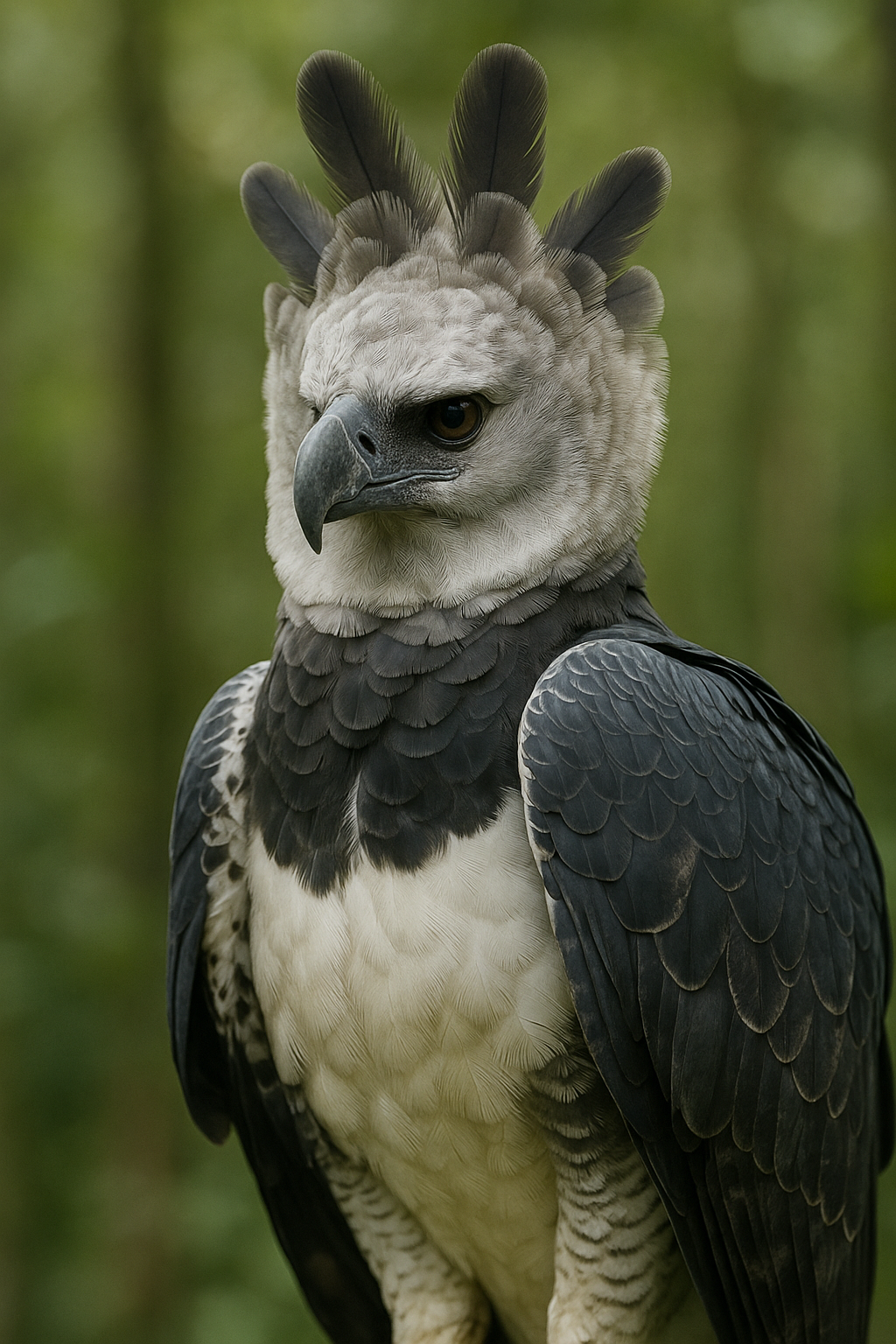Harpia harpyja is one of the largest raptors belonging to the family Accipitridae and is recognized as the largest eagle inhabiting continental America. This species is predominantly found in the tropical rainforests of the Amazon Basin. In terms of habitat preference, it favors lowland forested areas with dense and tall tree canopies. Its distribution ranges from southern Mexico to countries such as Brazil, Peru, Ecuador, Venezuela, Suriname, and French Guiana. However, this distribution is fragmented due to habitat loss. As the species is highly dependent on dense forest cover, deforestation and human activities have led to significant reductions in its natural habitat.

Harpy Eagle (Juan Felipe Ramírez,Pexels)
Morphological Characteristics and Physiology
The harpy eagle stands out with its powerful and robust build. Its average wingspan can reach up to 2 meters, while body length varies between approximately 90 and 105 cm. Females are generally larger than males, with weights ranging between 6 and 10 kg. One of the most striking features of the species is the pair of feathered crests located on its head. These crests may serve functions in visual communication and during hunting. The eyes are positioned forward, enabling stereoscopic vision and precise depth perception. Its talons are large and curved, designed to grasp prey with ease. The toes are thick and strong, a structure that allows the eagle to effectively hunt large mammals. Compared to other large eagles, its tail is short, and wings are relatively shorter and broader, enhancing maneuverability within dense forest environments.
Feeding Behavior and Predatory Ecology
The feeding strategies of Harpia harpyja are of critical importance for understanding its ecological niche. It is a predator specializing in avian and mammalian fauna found within forest interiors. Its primary prey includes sloths (Bradypus spp. and Choloepus spp.), various species of monkeys (such as Cebus, Alouatta, Saimiri), and large birds. Prey selection may vary across geographic regions. Observations in Suriname have shown that the harpy eagle’s diet predominantly consists of large mammals and arboreal prey species. Most of the prey consumed are species that dwell on tree trunks or high branches. Its hunting behavior often involves surprise attacks; the eagle silently waits on high branches to detect potential prey and then strikes with a sudden dive.
Studies on prey composition have revealed individual variations. Even individuals residing in the same region may display significant differences in dietary preferences. These variations are likely influenced by factors such as individual learning, prey availability, and competition pressures. In one documented case from Venezuela, a harpy eagle was observed preying upon an urvin howler monkey (Alouatta arctoidea). This observation demonstrates the species' high flexibility in both prey size and diversity.

Harpy Eagle, (Created with artificial intelligence.)
Reproductive Behavior and Life Cycle
The harpy eagle exhibits an extremely low reproductive rate and follows a reproductive strategy characterized by high parental investment. This monogamous species typically raises a single chick every two to three years. Females lay a single egg, with an incubation period of approximately 56 days. After hatching, the chick remains under parental supervision for around 10 months. However, the process of achieving independence is considerably slow; some juveniles may stay within the parents’ territory for up to 24 months. Nesting sites are usually located on high platforms in large trees. These nests are reused for many years and are continuously maintained. The preference for tall trees is primarily to avoid predators and to enable easier observation of potential prey. During the chick-rearing period, the parents regularly bring food by surveying extensive hunting territories.
Genetic Diversity and Population Structure
The harpy eagle exhibits a notable degree of genetic diversity across its populations. Molecular genetic studies indicate that the species retains conserved genetic variation, a positive indicator for long-term population health. Genetic analyses conducted in the Brazilian Amazon have revealed low levels of inbreeding and high haplotype diversity within populations. These findings suggest that both natural selection pressures and habitat-driven dispersal play influential roles.
Genetic differentiation also points to the existence of clear separations among populations. Limited gene flow has been observed between different subpopulations, likely reflecting the consequences of habitat fragmentation. Despite this, the current level of genetic diversity indicates that the species is not yet at a critical threshold in terms of genetic health. Preserving genetic resources is essential for future reintroduction and support programs and represents a valuable potential for long-term conservation planning.
Conservation Strategies and Management Perspectives
Conservation strategies for the harpy eagle must be structured by considering its biological characteristics and its role within ecosystems. Due to its low reproductive rate, high habitat requirements, and prey dependence, the species requires specific protection measures. The preservation of genetic resources is particularly critical for maintaining sustainable populations. The harpy eagle’s high genetic diversity increases its likelihood of long-term survival, provided that its natural habitats are effectively conserved. However, threats such as habitat loss, deforestation, and hunting pressure limit this potential.
In conservation programs, understanding prey dynamics and identifying the species' ecological functions are of great importance. As a top predator in the food chain, it contributes to the regulation of forest ecosystems. Moreover, monitoring the species and studying its behavior can serve as an ecological indicator for identifying environmental changes. Current conservation strategies should prioritize collaboration with local communities and continuous monitoring of genetic resources as fundamental principles.
Ecological Role and Interaction Dynamics
Harpia harpyja occupies the position of an “apex predator” in its native ecosystems. This status defines both its trophic impacts and its interactions with other species. By exerting predation pressure on prey populations, particularly large arboreal mammals, the eagle plays a role in regulating species densities. This regulation creates indirect benefits by preserving forest structure and maintaining understory vegetation balance. Additionally, the presence of highly specialized predators like the harpy eagle supports the sustainability of biological diversity.


